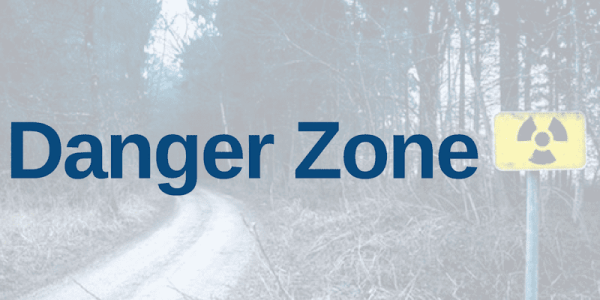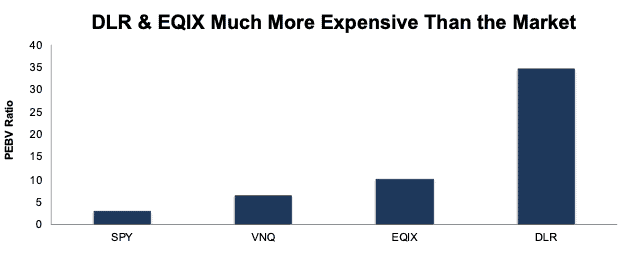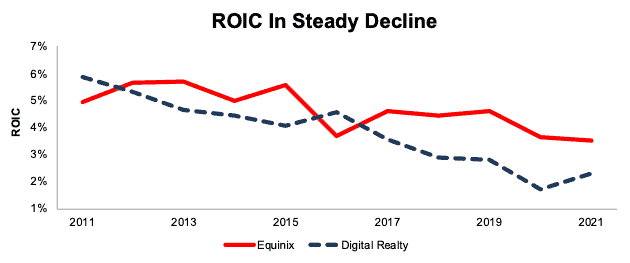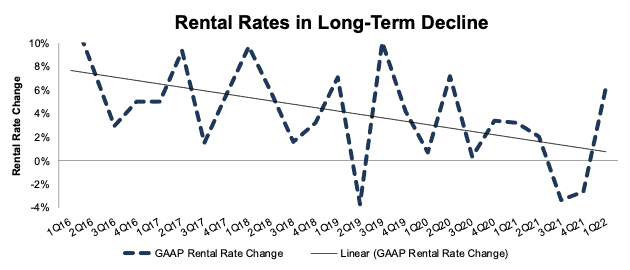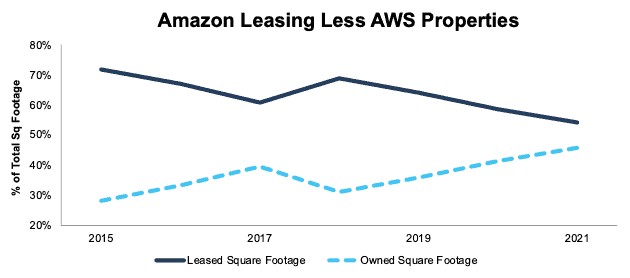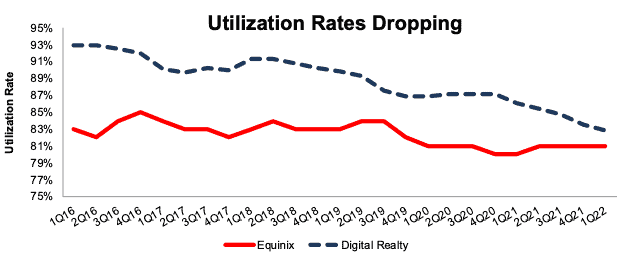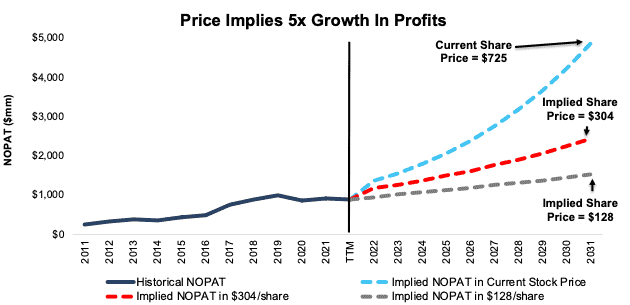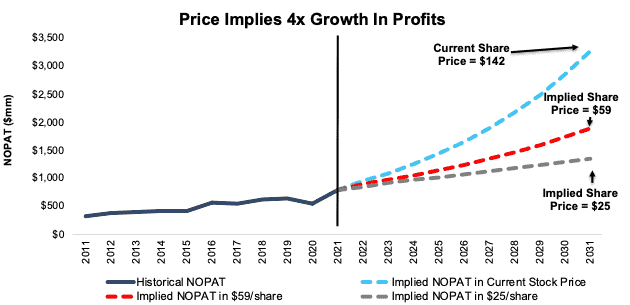We closed these Danger Zone picks on October 24, 2024. A copy of the associated Position Close report is here.
Bulls have long argued that data center operators, given their ties to data usage and the internet, deserve premium valuations. We disagree. Data center owners, specifically Equinix (EQIX: $715/share) and Digital Realty Trust (DLR: $141/share) are in the Danger Zone and exhibit poor risk/reward due to:
- years of declining profitability
- low pricing power in a commoditized industry
- deep-pocketed customers becoming competitors
- declining utilization of available data center capacity (overbuilding in good times)
- rising cost of commercial real estate makes improving return on invested capital (ROIC) unlikely
- stock prices that imply immediate reversal in declining margins and years of above consensus growth
This report leverages our cutting-edge Robo-Analyst technology to deliver proven-superior[1] fundamental research and support more cost-effective fulfillment of the fiduciary duty of care.
Data Center Stocks More Expensive Than Market and Overall REITs
Per Figure 1, the price-to-economic book value (PEBV) ratios of Equinix and Digital Realty Trust are significantly higher than those of Vanguard Real Estate Index Fund (VNQ), a broad measure of all different types of REITs, and the S&P 500, as measured by the State Street SPDR S&P 500 ETF (SPY). In other words, the expectations baked into the stock prices of EQIX and DLR dwarf not only their REIT peers in VNQ but also those of S&P 500, which includes some of the most profitable companies on the planet.
Figure 1: PEBV Ratio of DLR, EQIX, VNQ, and SPY – as of 5/6/22
Sources: New Constructs, LLC and company filings.
One of the most important aspects of a quality investment is buying a stock at a good price. In common terms, a good price means the implied expectations for future profits are overly pessimistic. Our PEBV ratio measures the difference between the market’s expectations for future profits and the no-growth value of a business. The higher the PEBV ratio, the higher the expectations for future profits are.
No Economics Profits in These Businesses
The fundamentals of Equinix and Digital Realty don’t warrant the valuation premium highlighted above. In fact, per Figure 2, the economic earnings, which account for the income statement and balance sheet, have steadily declined over the past decade.
Equinix’s economic earnings fell from $51 million in 2011 to -$197 million in 2021 while Digital Realty’s economic earnings fell from $61 million to -$620 million over the same time.
Figure 2: Equinix & Digital Realty’s Economic Earnings Since 2011
Sources: New Constructs, LLC and company filings.
Fundamentals Deteriorating as Well
Not only are Equinix’s and Digital Realty’s economic earnings in decline, both firms' net operating profit after-tax (NOPAT) margin, invested capital turns, and ROIC are falling, too.
Equinix’s NOPAT margin fell from 15.4% in 2011 to 13.7% in 2021 while Digital Realty’s NOPAT margin fell from 29.4% to 17.8% over the same time. Equinix’s invested capital turns, a measure of balance sheet efficiency, fell from 0.32 in 2011 to 0.26 in 2021 while Digital Realty’s invested capital turns fell from 0.20 to 0.13 over the same time.
Falling margins and invested capital turns drive each firm’s ROIC lower. Per Figure 3, Equinix’s ROIC declined from 5.0% in 2011 to 3.5% in 2021. Over the trailing twelve months (TTM) Equinix’s ROIC is even lower at 3.4%. Digital Realty’s ROIC declined from 5.9% in 2011 to 2.3% in 2021. DLR has not filed its 1Q22 10-Q yet, so we don’t have TTM ROIC data for the company.
Figure 3: Equinix & Digital Realty’s ROIC Since 2011
Sources: New Constructs, LLC and company filings.
Expanded Data Usage Isn’t Enough – Other Red Flags Abound
Rising data usage across the globe and digitalization of businesses and commerce have likely drawn investors to data center providers. We’re not here to argue that these companies don’t provide a useful service to their customers. However, the increasing need for data storage and general data usage is not enough to justify these companies’ valuations. There are multiple obstacles facing the industry that make it highly unlikely that Equinix and Digital Realty can justify the expectations baked into their stock prices, as we’ll show below.
Data Centers Reliant on Big Three Cloud Providers as Customers
Data center operators have benefited greatly from rising data usage and outsourcing of IT operations.
However, as more companies move to the cloud, for infrastructure, storage, compute power, the more the spoils are increasingly going to the trio of Amazon (AMZN) Web Services, Alphabet (GOOGL) and Microsoft (MSFT). In 1Q22, AWS, Microsoft, and Google accounted for 65% of the global spend on cloud computing, up from an estimated 47% in 2Q16.
Such growth and dominance have been good for data center REITs in the past, as the big three cloud players lease space in hyperscale data centers around the world. In fact, Microsoft leased more U.S. data center capacity than any other company in 2020.
On the other hand, the dominance of these three providers means they’re more important to data center REITs than ever. Smaller companies won’t want to lease capacity at a data center that doesn’t provide connection to the three largest cloud providers in the market, which means AWS, Microsoft, and Google have increasingly more leverage over their leased data center operators.
Cloud Firms’ Leverage Shows in Digital Realty’s Lack of Pricing Power
As the big cloud providers exert more influence on the market and other data center companies build out more capacity, leasing prices are trending lower. Figure 4 shows Digital Realty’s rental rate change (that is the beginning rental rate on leases renewed relative to the ending rental rate) and its downward trend since 1Q16.
Figure 4: Digital Realty’s Rental Rate Change Since 1Q16
Sources: New Constructs, LLC and company filings.
Biggest Clients Are Now Direct Competitors
Rather than lease data center capacity, Amazon, Microsoft, Google, and many other large tech companies are increasingly building their own. Building out their own data centers will eventually put these companies in direct competition with the likes of Equinix and Digital Realty, just as they have absorbed the markets of other types of mission-critical vendors in the past.
Equinix acknowledges a risk brought on by these cloud providers in its 10-K, stating “…with growing acceptance of cloud-based technologies, we are at risk of losing customers that may decide to fully leverage cloud infrastructure offerings instead of managing their own.” There’s another risk from this shift. While cloud providers build their own data centers, they no longer need space from existing data center owners.
Amazon represents a perfect example of this shift. The percent of property Amazon leases for AWS declined from 72% of total AWS property square footage in 2015 to 54% in 2021. Conversely, the percentage owned increased from 28% of total AWS property square footage in 2015 to 46% in 2021. See Figure 5.
Figure 5: Amazon AWS Property By % of Leased and Owned Property Since 2015
Sources: New Constructs, LLC and company filings.
Beyond Amazon, Microsoft announced plans in 2021 to build 50-100 new data centers each year “for the foreseeable future.” The company’s successful test of an underwater data center provides what is expected to become another lower-cost and more efficient alternative to legacy data centers. Microsoft sees these underwater facilities filling an increasing need for smaller data centers located closer to customers, while the larger legacy warehouse data centers locate further from cities in search of cheaper real estate.
Cloud Providers Are Formidable Competitors
AWS, Microsoft, and Google combined now account for over half of the largest data centers throughout the world. 2021 also saw an increasing number of self-built hyperscale data centers, with Meta (FB), Google, AWS, and Microsoft contributing 35% of the overall addition to hyperscale data center space in 2021. Meta was the leader in hyperscale development in the U.S., investing in 19 separate facilities in 2021.
Given the capital and cash resources available to these firms (Alphabet, Microsoft, and Meta’s TTM free cash flow of $101 billion is 6% less than the combined market cap of Equinix and Digital Realty), it’s not surprising they would want to bring all their data needs in house.
Cloud Infrastructure Services Expected to Grow Faster Than Physical Data Centers
As noted above, the rise of cloud infrastructure poses a threat to existing data center providers, and industry researchers expect cloud growth to dwarf traditional data center growth in the years to come.
- global data center: 5% growth compounded annually through 2027.
- cloud infrastructure services: 19% growth compounded annually through 2026.
In 2021 alone the cloud infrastructure market grew 38% year-over-year (YoY) while Equinix and Digital Realty grew revenue 11% and 13%, respectively.
Overbuilding Leaves Data Centers Less Utilized
We think too much capital crowded into global data center construction, as Equinix and Digital Realty are seeing lower utilization levels across their portfolios.
Equinix’s cabinet utilization rate (the percentage of cabinet space billed versus total capacity) excluding the impact of ongoing expansion projects was 81% in 1Q22, equal to 81% in 4Q21, and down from 83% in 1Q16 and a high of 85% in 4Q16.
Digital Realty’s utilization (which the company refers to as occupancy) fell to 83% in 1Q22, down from 84% in 4Q22, 93% in 1Q16, which is the highest utilization rate since 1Q16.
Figure 6: Equinix & Digital Realty Utilization/Occupancy Levels Since 1Q16
Sources: New Constructs, LLC and company filings.
Cost of Property Only Getting More Expensive
The Green Street Commercial Property Price Index, which captures the prices at which commercial real estate transactions are being negotiated and contracted, reached all-time highs for both North America and Europe in April 2022, after rising slightly over March’s previous record high. Record high prices are also joined by rising costs of borrowing.
In early April, Green Street’s Co-Head of Strategic Research, Peter Rothemund noted “the yield on the 10-year Treasury is up 100 points since December and borrowing costs, whether that’s mortgages or unsecured notes issued by REITs, are up even more.”
Data center REITs, such as Equinix and Digital Realty earned poor ROICs during one of the lowest interest rate decades throughout history. Now, as interest rates rise, along with the already expensive and rising price of commercial real estate, the likelihood of ROIC improving is low.
Industry Consolidation Leaves Fewer M&A Growth Opportunities or Takeover Prospects
As the data center market matures and pricing power comes under pressure, consolidation amongst players has begun. However, consolidation has mostly occurred within smaller firms, leaving Digital Realty and Equinix fewer roll-up acquisition opportunities. Given that capital was already deployed to acquire competitors, Digital Realty and Equinix are even more unlikely to receive any buyout/takeover offer at a premium to their already overvalued stock prices.
For instance, in the past few months American Tower Corp (ATM) acquired CoreSite for $10 billion, KKR and GIP acquired CyrusOne for $15 billion, and Blackstone Inc. (BX) acquired QTS Realty for $10 billion.
Despite Obvious Headwinds, EQIX and DLR Remain Overvalued
At just $71/share and $4/share, Equinix’s and Digital Realty’s respective economic book values illustrate the overly optimistic expectations embedded in each company’s stock price. Below, we use our reverse discounted cash flow (DCF) model to (1) quantify the expectations for future profit growth implied by Equinix’s and Digital Realty’s current stock prices and (2) analyze the stock prices implied by more reasonable profit growth expectations.
EQIX Is Priced to Achieve Nearly Half AWS Revenue and Grow Profits 5.5x TTM Levels
We find that at ~$715/share, Equinix is priced as if it will immediately reverse its long trend of falling margins and grow revenue at above-consensus rates for a decade.
Specifically, to justify its current price Equinix must:
- improve its NOPAT margin to 18% (highest in company history, compared to 13% TTM) and
- grow revenue by 15% compounded annually for the next 10 years (vs. consensus estimates of 10% in 2022 and 8% in 2023)
In this scenario, Equinix generates nearly $28 billion in revenue in 2031 or 4x Equinix’s TTM revenue and 8% of the implied global data center market in 2031[2], up from an estimated 3% in 2021. For additional comparison, $28 billion in revenue would equal 44% of AWS’ revenue in 2021, while Equinix’s actual 2021 revenue was just 11% of AWS’ 2021 revenue.
In this scenario, Equinix would also generate $4.8 billion in NOPAT in 2031, which would be 5.5x greater than the company’s TTM NOPAT and 4.9x greater than the company’s highest ever NOPAT, which was achieved in 2019. These expectations for future profits seem overly optimistic for a company that grew NOPAT by just 2% from 2018 to 2021.
There Is 58%+ Downside at Consensus Growth Rates: In this scenario, Equinix’s:
- NOPAT margin improves to 16% (5-year average, compared to 13% TTM),
- revenue grows at consensus rates in 2022 and 2023, and
- revenue grows 8% a year 2024 through 2031 (continuation of 2023 consensus growth rate), then
the stock is worth just $306/share today – a 57% downside to the current price. If Equinix’s growth slows to consensus rates, or it is unable to improve margins beyond current levels, the downside risk in the stock is even higher, as we show below.
There Is 82%+ Downside If Growth Slows to Industry Rates: In this scenario, Equinix’s
- NOPAT margin stabilizes 13% (equal to TTM),
- revenue grows at consensus rates in 2022 and 2023, and
- revenue grows 5% a year from 2024 through 2031 (equal to projected global data center growth rate through 2027), then
the stock is worth just $128/share today – an 82% downside to the current price.
Figure 7 compares Equinix’s historical NOPAT and implied NOPAT for the three scenarios we presented to illustrate just how high the expectations baked into Equinix’s stock price are.
Figure 7: Equinix’s Historical NOPAT vs. DCF Implied Revenue
Sources: New Constructs, LLC and company filings
Each of the above scenarios also assumes Equinix’s change in invested capital equals 10% of revenue in each year of our DCF. For reference, Equinix’s change in invested capital has averaged 52% of revenue over the past five years and 53% of revenue over the past 10 years. For this scenario to occur in the real world, Equinix would need to (instantly and without cost) become much more efficient at generating revenue per dollar of capital put into the business. Such an outcome is highly unlikely to occur but allows us to model truly best-case scenarios. If we assume Equinix’s invested capital increases at a similar rate to historical levels, the downside risk is even larger.
DLR Is Priced to More than Double Market Share and Grow Profits 4x Higher Than 2021
We find that at $141/share, Digital Realty is also priced as if it will immediately reverse its trend of falling margins and grow revenue at above consensus rates for a decade.
Specifically, to justify its current price Digital Realty must:
- improve its NOPAT margin to 19% (5-year average, compared to 18% in 2021) and
- grow revenue by 15% compounded annually for the next 10 years (vs. consensus estimates of 7% in 2022 and 9% in 2023)
In this scenario, Digital Realty generates $17.5 billion in revenue in 2031 or 4x Digital Realty’s 2021 revenue, one-fourth of AWS’ 2021 revenue, and 5% of the implied global data center market in 2031[3], up from an estimated 2% in 2021.
In this scenario, Digital Realty would also generate $3.3 billion in NOPAT in 2031, which would be 4.2x greater than the company’s 2021 NOPAT, which was its highest ever NOPAT.
There Is 58%+ Downside at Consensus Growth Rates: In this scenario, Digital Realty’s:
- NOPAT margin improves 19% (5-year average),
- revenue grows at consensus rates in 2022 and 2023, and
- revenue grows 9% a year 2024 through 2031 (continuation of 2023 consensus growth rate), then
the stock is worth just $59/share today – a 58% downside to the current price. If Digital Realty’s growth slows to consensus rates, or its unable to improve margins beyond current levels, the downside risk in the stock is even higher, as we show below.
There Is 82%+ Downside If Growth Slows to Industry Rates: In this scenario, Digital Realty’s
- NOPAT margin equals 18% (equal to 2021),
- revenue grows at consensus rates in 2022 and 2023, and
- revenue grows 5% a year from 2024 through 2031 (equal to global data center growth rate through 2027), then
the stock is worth just $26/share today – an 82% downside to the current price.
Figure 8 compares the firm’s historical NOPAT and implied NOPAT for the three scenarios we presented to illustrate just how high the expectations baked into Digital Realty’s stock price are.
Figure 8: Digital Realty’s Historical NOPAT vs. DCF Implied Revenue
Sources: New Constructs, LLC and company filings
Each of the above scenarios also assumes Digital Realty’s change in invested capital equals 10% of revenue in each year of our DCF. For reference, Digital Realty’s change in invested capital has averaged 145% of revenue over the past five years and 115% of revenue over the past 10 years. If we exclude the $8.4 billion acquisition of Interxion, which closed in 2020, Digital Realty’s change in invested capital has still averaged 94% of revenue since 2012. As was the case for Equinix, for this to occur in the real-world Digital Realty would need to (instantly and without cost) become much more efficient at generating revenue per dollar of capital put into the business. Such an outcome is highly unlikely to occur but allows us to model truly best-case scenarios. If we assume Digital Realty’s invested capital increases at a similar rate to historical levels, the downside risk is even larger.
Check out this week’s Danger Zone interview with Chuck Jaffe of Money Life.
This article originally published on May 9, 2022.
Disclosure: David Trainer, Kyle Guske II, and Matt Shuler receive no compensation to write about any specific stock, sector, style, or theme.
Follow us on Twitter, Facebook, LinkedIn, and StockTwits for real-time alerts on all our research.
[1] Our research utilizes our Core Earnings, a more reliable measure of profits, as proven in Core Earnings: New Data & Evidence, written by professors at Harvard Business School (HBS) & MIT Sloan and published in The Journal of Financial Economics.
[2] Assumes the global data center market continues growing from 2028-2031 at the same CAGR as projected from 2021-2027.
[3] Assumes the global data center market continues growing from 2028-2031 at the same CAGR as projected from 2021-2027.
